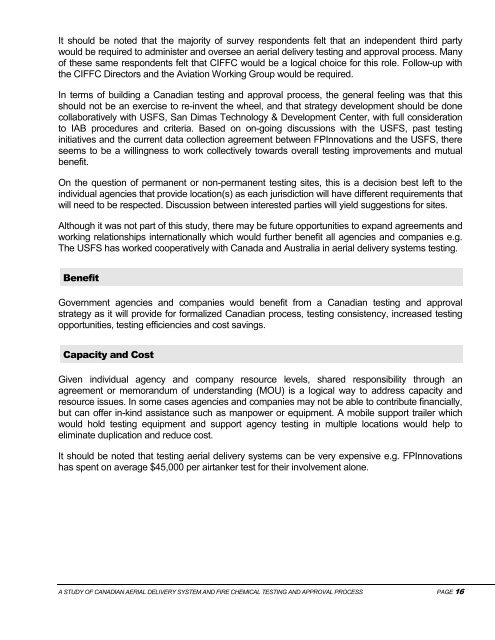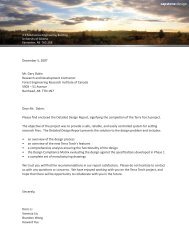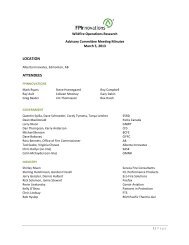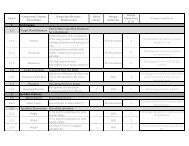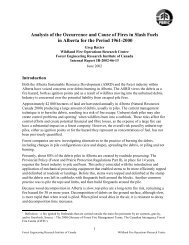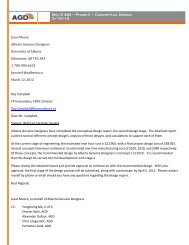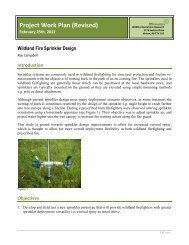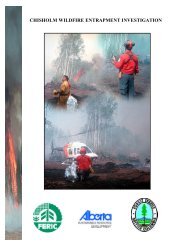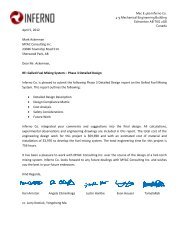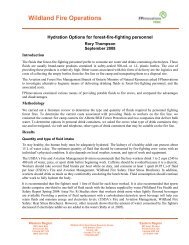A Study of Canadian Aerial Firefighting Delivery System and Fire ...
A Study of Canadian Aerial Firefighting Delivery System and Fire ...
A Study of Canadian Aerial Firefighting Delivery System and Fire ...
Create successful ePaper yourself
Turn your PDF publications into a flip-book with our unique Google optimized e-Paper software.
It should be noted that the majority <strong>of</strong> survey respondents felt that an independent third partywould be required to administer <strong>and</strong> oversee an aerial delivery testing <strong>and</strong> approval process. Many<strong>of</strong> these same respondents felt that CIFFC would be a logical choice for this role. Follow-up withthe CIFFC Directors <strong>and</strong> the Aviation Working Group would be required.In terms <strong>of</strong> building a <strong>Canadian</strong> testing <strong>and</strong> approval process, the general feeling was that thisshould not be an exercise to re-invent the wheel, <strong>and</strong> that strategy development should be donecollaboratively with USFS, San Dimas Technology & Development Center, with full considerationto IAB procedures <strong>and</strong> criteria. Based on on-going discussions with the USFS, past testinginitiatives <strong>and</strong> the current data collection agreement between FPInnovations <strong>and</strong> the USFS, thereseems to be a willingness to work collectively towards overall testing improvements <strong>and</strong> mutualbenefit.On the question <strong>of</strong> permanent or non-permanent testing sites, this is a decision best left to theindividual agencies that provide location(s) as each jurisdiction will have different requirements thatwill need to be respected. Discussion between interested parties will yield suggestions for sites.Although it was not part <strong>of</strong> this study, there may be future opportunities to exp<strong>and</strong> agreements <strong>and</strong>working relationships internationally which would further benefit all agencies <strong>and</strong> companies e.g.The USFS has worked cooperatively with Canada <strong>and</strong> Australia in aerial delivery systems testing.BenefitGovernment agencies <strong>and</strong> companies would benefit from a <strong>Canadian</strong> testing <strong>and</strong> approvalstrategy as it will provide for formalized <strong>Canadian</strong> process, testing consistency, increased testingopportunities, testing efficiencies <strong>and</strong> cost savings.Capacity <strong>and</strong> CostGiven individual agency <strong>and</strong> company resource levels, shared responsibility through anagreement or memor<strong>and</strong>um <strong>of</strong> underst<strong>and</strong>ing (MOU) is a logical way to address capacity <strong>and</strong>resource issues. In some cases agencies <strong>and</strong> companies may not be able to contribute financially,but can <strong>of</strong>fer in-kind assistance such as manpower or equipment. A mobile support trailer whichwould hold testing equipment <strong>and</strong> support agency testing in multiple locations would help toeliminate duplication <strong>and</strong> reduce cost.It should be noted that testing aerial delivery systems can be very expensive e.g. FPInnovationshas spent on average $45,000 per airtanker test for their involvement alone.A STUDY OF CANADIAN AERIAL DELIVERY SYSTEM AND FIRE CHEMICAL TESTING AND APPROVAL PROCESS PAGE 16


